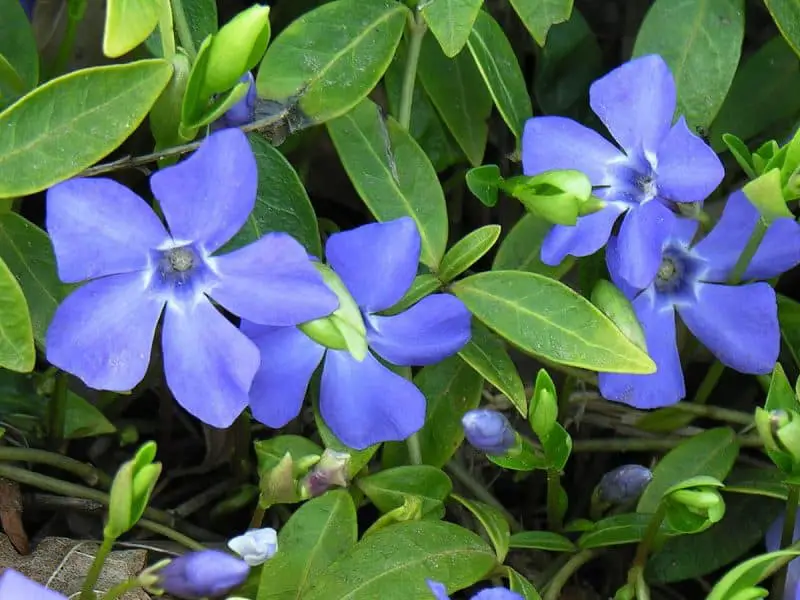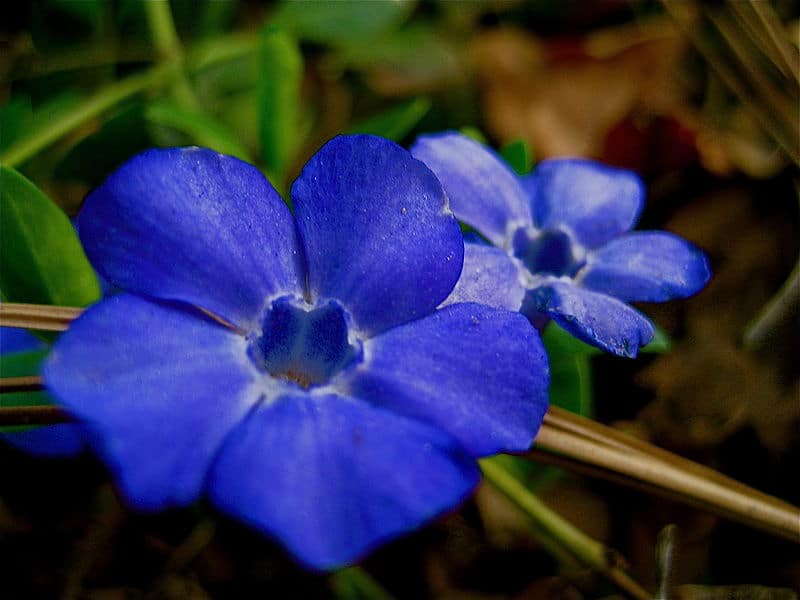This post contains affiliate links. If you buy something from one of our links we may earn a commission. Thanks

Vinca minor is a popular landscape plant usually grown outdoors. But did you know you can grow Vinca Vine in pots indoors? Here’s how to grow Vinca Vine indoors.
Vinca Vine Key Takeaways:
- Growing Vinca Vine in pots indoors is a rewarding endeavor.
- Provide them with 3-4 hours of sunlight daily.
- Use a well-draining potting mix, and a balanced fertilizer monthly during the growing season.
- Ensure a humid environment and keep the temperature between 65 and 85 degrees F.
- Vinca minor is the preferred variety for indoor cultivation due to its tolerance to lower light levels.
What Is Vinca Minor
Vinca minor is a very attractive ground cover with dark green leaves and beautiful blue flowers. It is an evergreen perennial.
Most people are unaware you can grow Vinca Vine in pots. You can also grow it as a Vinca Vine hanging basket.
Vinca minor (common names lesser periwinkle or dwarf periwinkle) is a species of flowering plant in the dogbane family, native to central and southern Europe, from Portugal and France north to the Netherlands and the Baltic States, east to the Caucasus, and also southwestern Asia in Turkey. https://en.wikipedia.org/wiki/Vinca_minor
This is an extremely attractive houseplant that does not get near the attention it should.
Not only is it attractive but it is also very easy to grow indoors.
Growing Vinca Vine In Pots – Vinca Varieties
Yes, you can grow Vinca Vines in pots. There are actually 2 different species Vinca minor and Vinca major and both can be grown indoors.
Vinca major is also called bigleaf periwinkle and has similar care and larger leaves. Vinca major has larger heart-shaped leaves.
There is also Vinca Rosea now named Catharanthus roseus and it comes in reds, whites, and pinks.
But it is an annual bedding plant that needs high heat and humidity and will be very hard to grow indoors.
So make sure you are growing vinca minor or vinca major inside. Here is a Vinca major flower below.

How To Make Vinca Vines Flower Indoors
Before you start growing vinca indoors there are a few things you need to know to make Vinca Vines flower.
Vinca is a tough plant, It grows throughout Europe so it is cold hardy. It also tolerates shade and is often used under trees in the landscape.
But if you want your vinca to flower indoors you will want to keep it warm and give it sunlight.
You can grow it in a cool spot and in low-light conditions if you wish. It will grow just fine but it probably won’t flower.
Vinca needs at least 3-4 hours of sunlight daily to flower. More is better.
Remember you are indoors and the sun coming through a window is not as strong as it is outdoors. Also, the winter sun is much weaker.
Even shade outdoors is much brighter than your low light areas.
Vinca minor flowers during the sunny warmer days of summer so you will want to replicate this indoors if you want flowers.
Even as a sprawling evergreen vinca looks great in a hanging basket without flowers.
But if you want it to flower it needs higher light levels.
Even a south window may not be enough because many areas are cloudy during the winter. So consider adding some supplemental lighting.
Now that you know how to make your Vinca Vines flower we can talk about general care for vinca.
How To Grow Vinca Vine Indoors
Vinca minor, also known as periwinkle or myrtle, is a vining plant with glossy green leaves and blue or purple flowers.
This evergreen plant is native to Europe, but it has been introduced to North America, where it is often used as an ornamental ground cover. However, it also makes an attractive houseplant
Vinca Light Requirements
Vinca minor is tolerant of a wide range of light conditions, from full sun to partial shade.
However, the plant will flower best when grown in an area that receives at least six hours of direct sunlight each day.
When grown indoors, vinca minor should be placed in a south- or east-facing window.
Watering Vinca Minor Indoors
Vinca minor is a versatile ground cover that can be used in a variety of settings. Though it is often planted outdoors, it can also thrive indoors if given the proper care.
When watering vinca minor in pots, it is important to never let the soil dry out completely. Allow the top inch or so of soil to dry out before watering again.
Vinca is also a tolerant plant and can withstand occasional periods of drought. However, if the leaves begin to wilt, this is a sign that the plant is thirsty and needs more water.
With regular watering and plenty of sunlight, vinca minor will thrive indoors and add a touch of green to any space.
Humidity For Vinca Vine Indoors
Vinca minor plants are relatively easy to care for and can thrive in a variety of different environments.
One way to grow vinca minor is in pots. When growing vinca minor in pots, it is important to pay attention to the humidity levels.
Vincas prefer humid conditions and will not do well if the air is too dry. Vinca grows best at a humidity of 50-70%
One way to increase the humidity around your vinca minor plant is to place the pot on a tray of pebbles and water.
The water will evaporate and help to increase the humidity around the plant.
If the air in your home is dry you might also want to mist your plant to help increase humidity around it.
Temperature For Vinca Minor In Pots
Vinca minor is a tough adaptable plant but indoors it’s a good idea to keep your Vinca minor at a constant temperature between 65 and 85 degrees F.
Try to keep your Vinca away from drafts and sources of hot or cold air like heating vents or air conditioners.
Vinca Vine In Pots Soil
If you are going to grow vinca in pots you will need a potting mix that drains well.
Vinca is not fussy about soil and just about any well-draining potting mix will work.
When planting vinca minor in containers, use a well-draining potting mix and make sure the pot has drainage holes.
I like to use coco coir because it retains water well but drains quickly.
Water vinca regularly, but allow the soil to dry out between waterings.
Fertilizing Vinca Vine In Pots
Vinca minor is relatively easy to care for, but there are a few things to keep in mind when it comes to fertilization.
Vinca is a hardy plant that can thrive even in poor soil outdoors but since it is now inside we want to take good care of it.
Apply a balanced fertilizer every month during the growing season, taking care not to overfertilize.
Be sure to follow the manufacturer’s instructions, as too much fertilizer can damage vinca minor’s roots.
Vinca Vine Propagation
Vinca minor, or Vinca Vine, is a beautiful and hardy plant that can be propagated using stem cuttings.
To take a cutting, simply snip a four- to six-inch piece of stem from a healthy Vinca Vine and remove the bottom leaves.
Next, dip the cutting in rooting hormone and plant it in moist, well-drained soil.
Keep the soil moist but not soggy, and within a few weeks, you should see new growth.
Once the Vinca Vine has established itself, it can be transplanted to its permanent location.
With a little care and patience, you can easily propagate Vinca Vines from stem cuttings.
Pruning Vinca Vine in pots
Your Vinca Vine is fast growing and will require regular pruning. Vinca will not grow more than 6-12 inches tall.
But the vines can grow many yards long outdoors and in some areas it is considered an invasive species.
But don’t worry with proper pruning Vinca Vines will not take over your house.
You will want to cut long vines back to a node. This will help keep the plant bushier.
You can pinch back growth tips on vines to help maintain the desired length.
Deadheading
If you want to keep your vinca flowering consistently you will want to remove older flowers as they start to fade. This is called deadheading.
Is Vinca Toxic?
It is true that all parts of Vinca are considered poisonous to humans, dogs, and cats.
However, the plant’s most toxic variety (Catharanthus roseus) contains alkaloids that can be very damaging if consumed by animals such as horses or cows. https://www.aspca.org/pet-care/animal-poison-control/toxic-and-non-toxic-plants/vinca
While other plants like Vinca minor or vinca major are only considered mildly toxic and may not cause any problems at all.
Regardless of what type of vinca you are growing it is a good idea to keep it out of reach of children and pets.
Vinca does very well in hanging baskets and this is a great way to keep this plant out of reach.
Vinca Vine FAQs:
Embarking on the journey of growing Vinca Vine indoors invites a lot of queries.
Here are some frequently asked questions to guide you through a successful indoor gardening experience with Vinca Vines.
Q. How often should Vinca Vines be watered when grown in pots indoors?
A. Allow the top inch of soil to dry before watering again. While Vinca is drought-tolerant, wilted leaves indicate it’s time for a drink.
Q. What kind of fertilizer is suitable for Vinca Vine in pots?
A. Utilize a balanced fertilizer monthly during the growing season, adhering to the manufacturer’s instructions to avoid over-fertilization.
Q. How can I encourage my indoor Vinca Vine to flower?
A. Ensure 3-4 hours of sunlight daily, more if possible, and keep it in a warm spot.
While it grows in cool, low-light conditions, flowering is maximized with more light.
Q. Is Vinca Vine toxic to pets or humans?
A. Yes, all parts of Vinca are considered poisonous. It’s wise to keep Vinca out of reach of children and pets, possibly by utilizing hanging baskets for cultivation.
Vinca Vine In Pots Final Thoughts
To grow Vinca Vine in pots, you will need to provide it with 3-4 hours of sunlight daily and keep it in a warm location if you want flowers.
Vinca minor is the best variety to grow indoors, as it is more tolerant of lower light levels than other varieties.
Vinca Vines make very attractive plants for hanging baskets whether they are flowering or not.
With proper care, your Vinca Vine should thrive and produce beautiful blue flowers throughout the year.






